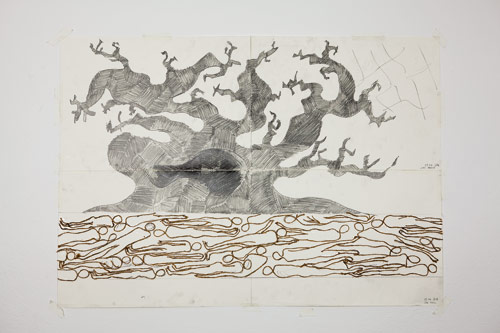Archéologie marine
2014
El Hadji Sy
From Gorée Island, right off the coast of Dakar, to Recife in Brazil’s northeastern coast, there are just over 3,170 kilometres: a distance that by today’s standards is arguably small. This, however, does not translate in ease of travel, meaningful cultural proximity or substantial economic exchange – in painful contrast to what happened throughout the seventeenth and eighteenth centuries, when men and women passed through the island as they crossed the Atlantic, involuntary, as slaves. These were just a few of those who embarked on such journey – a journey that only some of them would complete alive.

This forced travel not only shaped a great part of Brazil’s cultural and political history and that of other Latin American countries; it also resulted in an ocean that is literally filled with bodies – bodies that, if we pay enough attention, we might be able to see and feel.
Such an image provides the basis of Archéologie marine [Marine Archaeology], El Hadji Sy’s contribution to the 31st Bienal, which comprises a corridor delimited on the one side by an oceanic path, suspended from the ceiling and made up of these bodies, lying parallel to an enormous baobab that, like a giant octopus with large, tentacle-branches, gathers those bodies around itself and retains the memory of their histories.

Inside the corridor, the bodies of those visiting are both swallowed by the space and partly visible to those approaching – their legs and arms stretched below and over the oceanic path. As in El Sy’s previous work, painting is just part of the story here – an element that builds on materials (sacks, nets, pigments, etc.) that have their own history; and on performative and collaborative setups that give his works an evolving life of their own. In Archéologie marine, the engagement of people with this double vision will allow them to live, in their own bodies, the memory of history – a history that is not intended as an homage or lamentation, but as the starting point for the narration of a possible future in which old relations are reconstructed and others are created anew. – PL